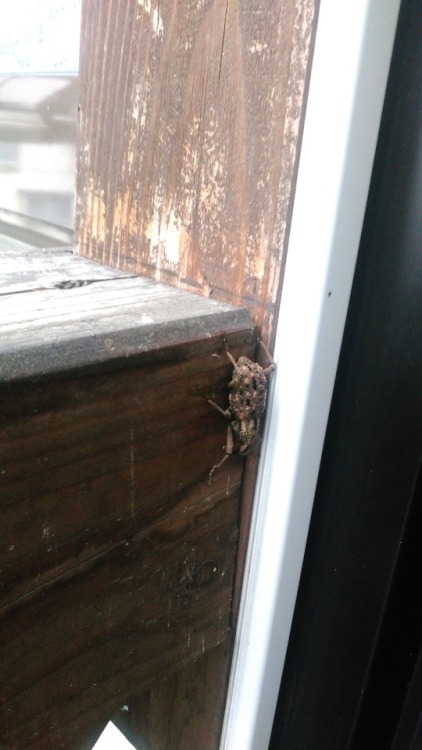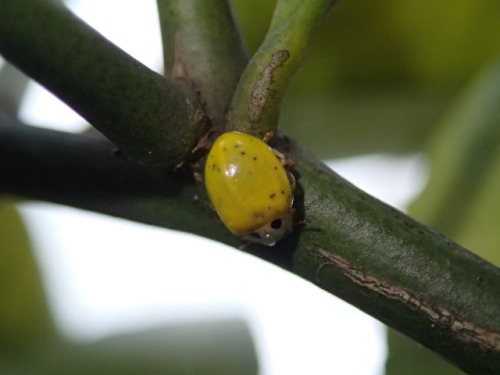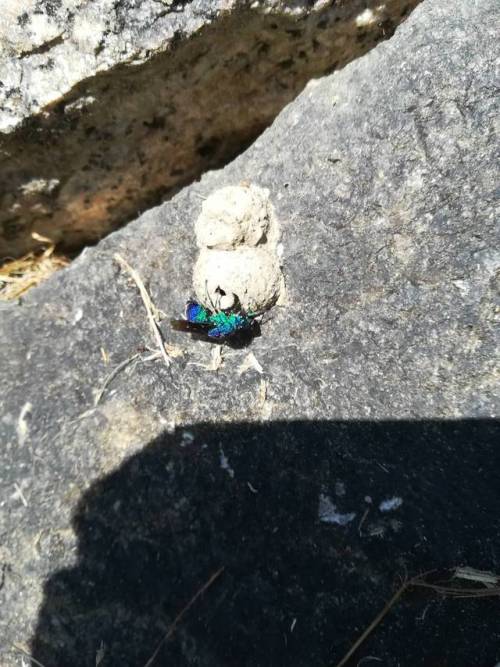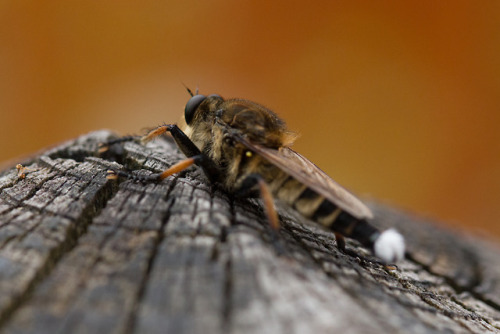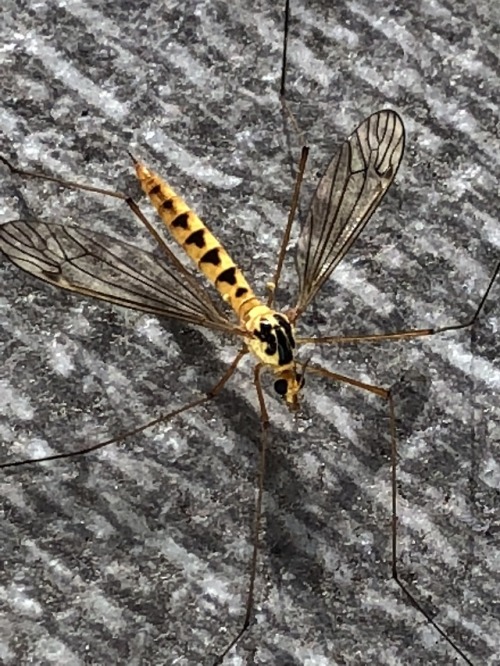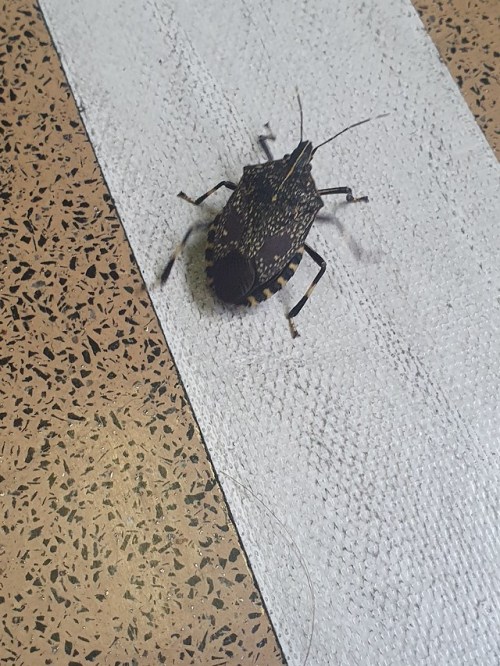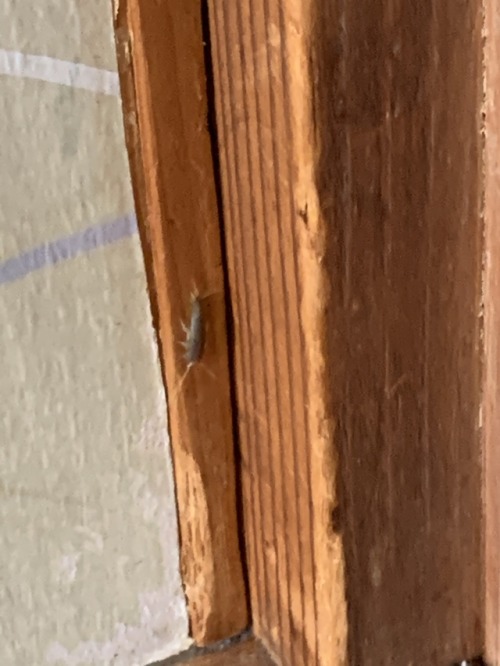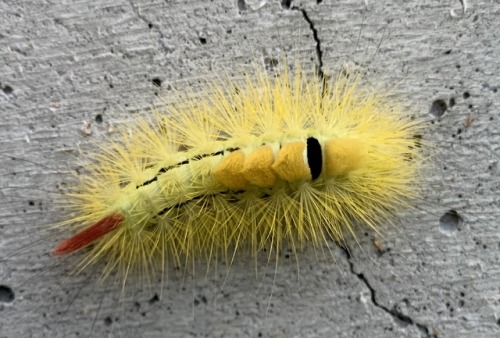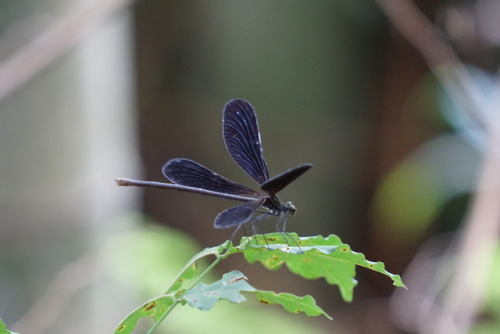#bugs of japan
“I have been try so hard to figure out what this cute, fuzzy little guy is called..but I can’t find anything. Found him in Yokohama-shi!”
I am reasonably certain that your fuzzy flat caterpillar is a type of
Lappet Moth
that are often found on pine trees in Japan. They’re known as
カレハ蛾 “Kareha-ga"
moths in Japanese. I couldn’t find one with that particular coloration on the page of Lappet Moths, but the low carriage, wide stance, body shape, black tuft in front and large face all resemble that family as far as I can tell, so this is my best guess. Thanks again for your submission and have a great fall!
Comparison photos of Lappet Moths
Post link
Next to my front door today, what the heck is this guy? - @callmegallifreya
Hey! Thank you for your submission and sorry for the long wait.
At first glance I could see you have a Weevil of some type (ゾウムシ、”Zoumushi”, Elephant Bug), but it took some digging to find precisely which one. Japan has around 1000 species of weevils (!).
I always love when I stumble across something in the most roundabout way, like searching for “Black long horn beetle with yellow spots and white and black antenna that lives in Honshu” and it turns out to be called a “yellow spot Longhorn” or something. It always makes me facepalm because I should honestly remember people name insects with simplicity. Today I should have taken that lesson to heart because you have a
オオゾウムシ Oo-zoumushi, “Big Weevil”( Sipalinus gigas).
English name: Giant Weevil. it is the largest weevil in Japan!
Size: 12-34mm
Description: Like other weevils, its proboscis is long and curved downward, giving it the charming Japanese name of “Elephant Bug”. The entire exoskeleton is textured with bumps. A newly-emerged weevil has a fine brown powdery texture over its entire body like velvet, but this is eventually worn away, with older individuals showing more black ‘background color under the paint’, as it were. Bold black streaks along the mottled brown body distinguish this weevil from others with similar brown coloration.
Distribution: Indonesia, Philippines, China, Taiwan, Korea, Kyushu to Hokkaido.
Behavior: It is known to be drawn to lights at night, and can be found on fallen trees in forests where stag beetles also hang out. These weevils will play dead if harassed, and Japanese Wikipedia also notes they have sharp claws that cling tightly to surfaces such as trees or a human hand, and they are difficult to pull off of a surface. They will continue to cling to a tree so tightly you can pull their legs off before they’ll let go! :o
Weevils place their eggs in weak and dead trees and the larvae burrow inwards to feed on trees such as pines, chestnuts and elms. It is considered a pest in lumberyards because it prefers to lay its eggs in dead wood. (Well, it seems a very logical mistake to make, on the weevil’s part.)
Thanks again for your submission!
Post link
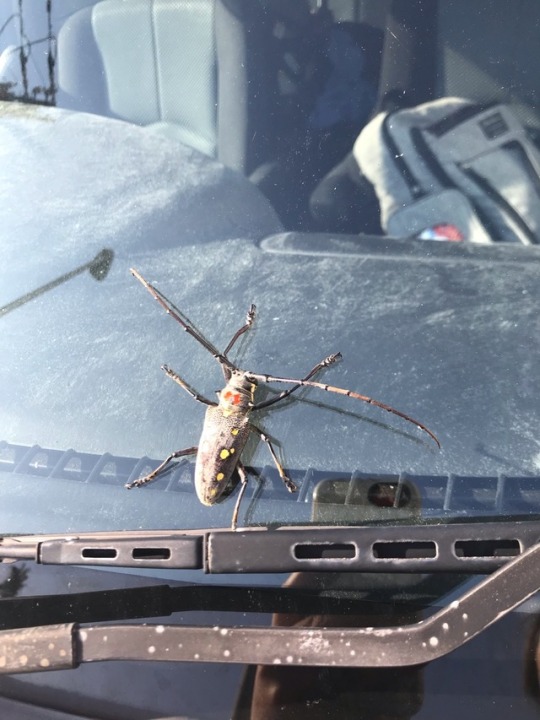
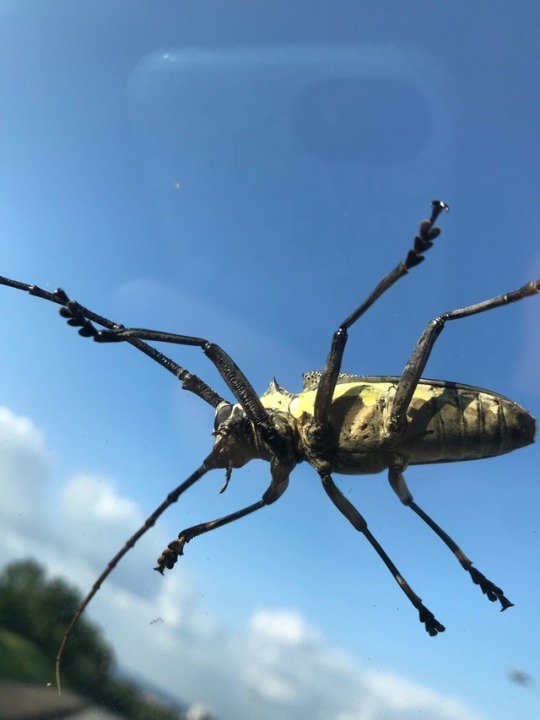
“Overall about the size of my palm. Picture taken in Okinawa if that helps identify.” – @jngirl2
Hello! Not only does it help, it was absolutely vitalin identifying this type of Longhorn Beetle. This particular Longhorn is ONLY found in Okinawa. It is a Fig Longhorn, Batocera rubus Linnaeus (”Ichijiku Kamikiri-Mushi”): See page here in Japanese.
This Longhorn deposits its eggs in fig and mulberry trees.
The larvae of the Longhorns bore into living trees (or untreated wood) and can be considered pests in some areas or ecosystems. It does not bite, sting or have poison, or have any other particular defense against humans. Some areas of the world have so much trouble with these beetles in trees that they are considered serious threats. However the Fig Longhorn does not appear in any lists of particularly vilified species.
Thank you for sending me this tropical beauty!
“Is this good for my mikan tree or bad? It was walking and sitting on the branches, not on the leaves… This is near Osaka.”
Hello, thanks for your submission!
There are lots of small beetles that look like ladybugs, but I am fairly certain this is a yellow ladybug (they do exist!). It might even be Illeis koebelei, a small yellow ladybug that feeds on mildew.
(compare with this image)

https://mushinavi.com/
キイロテントウ
Illeis koebelei
If it’s a ladybug, you can rest assured it’s definitely good for the mikan tree, as these little beetles clean mildew off the plant. Other ladybug species (such as the famous Seven Spotted) are predators and feed on small insects, particularly aphids but they will eat anything they can outrun. It’s amazing what a diversity of animals you can find even on a single tree! Thanks for your submission!
Post link
“We are new to Sasebo, Japan and were greeted by the front door of our unit in the tower we live in by this beauty butterfly earlier this summer. It must have known we love insects and was hopeful that we’d be able to help it find it’s way back outside to safety. We were able to get this very large and beautiful butterfly outside and were gifted with a couple pictures before it left. I think it’s a Papilio maackii, but don’t know for sure. Also can you tell from the photo if this one is male or female? Thanks so much!”
Thanks so much for submitting that awesome photo of the swallowtail butterfly you found in Kyushu. It’s an incredible individual, what a brilliant find.
I looked carefully at photos of Papilio maackii to compare, but it looks slightly different. maackii seems to always have a line of iridescent teal running along the lower edge of the hindwings with a stripe of black above and below it. Due to the absence of this line, I believe you’ve found a Papilio dehaani, with the slightly disappointing Japanese name of “Karasu-ageha”and the much more complementary English name of “Chinese Peacock Butterfly”.
Compare with this photo!
which has similar whitish brushing on the forewings, row of red spots on the hindwings, and clear delineation on the hindwings between the iridescent green/blue area and the deep black area where the red spots occur. Another reference:
This photo: Shows an identified male at a puddle.
Thus with reasonable confidence I will say you’ve got a very robust female Papilio dehaani! Many other examples I saw of this butterfly did not show such a full set of spots or such breadth of wing, but yours looks extremely healthy. She must have had a whole mikan tree to herself as a caterpillar!The red spots are present in the females, to a greater or total degree compared to the males, of many swallowtails, particularly in Japan.
- Special notes: Spring and summer generations produce different looking adults. There is both a spring form and a summer form for this butterfly.
Larval food
Rutaceae:
- Citrus depressa
- Citrus junos
- Citrus tachibana
- Euodia gabrifolia
- Euodia lepta
- Euodia meliaefolia
- Orixa japonica
- Phellodendron amurense
- Poncirus trifoliata
- Skimmia japonica
- Zanthoxylum ailanthoides
- Zanthoxylum nitidum
- Zanthoxylum piperitum
- Zanthoxylum schinifolium
I have been told that Kuro-ageha and Karasu-ageha are rare to find in Japan, even the caterpillars, although they feed on all citrus plants as swallowtails do. Thank you again for your great submission and feel free to ask if you find any other bugs!
Post link
“Saw this strange insect in Kyoto, going in and out of this nest structure. The colour struck me as very odd. I thought it was a weird bee or something at first, but upon closer inspection the head looks more fly-like. I was unable to identify it online, so I’m hoping someone else can!”
オオセイボウ(Stilbum cyanurum), Large Cuckoo Wasp
Hello!
Thanks so much for your submission. I hadn’t seen that handsome blue insect before, but your very helpful shot of its nest was enough to convince me I was looking at a wasp of some sort. So your first thought was absolutely right. I was able to ID it fairly certainly asStilbum cyanurum,https://en.wikipedia.org/wiki/Stilbum_cyanurum or in Japanese, オオセイボウ.(Ooseibou).
Comparison photos here:https://s2014no64.at.webry.info/201109/article_16.html
Distribution: Honshu, Shikoku, Kyushu, Okinawa
Size: 12 - 20 mm
It is indeed a type of Cuckoo Wasp. They have a stinger, but Cuckoo Wasps are not normally known to sting except in the most dire self-defense. Indeed, the photos on the blog above show someone handling it quite calmly. They’re widespread even across Europe, and though the adults feed on nectar like normal wasps, they capture and paralyze prey insects on which to lay their eggs in the nests. The larvae hatch out onto a ready meal.
Wonderful find and thank you for the submission!
Post link
@derberner “Saw this insect at Fushimi Inari Taisha in early August. It was nearly the size of the large dragonfly it chased off. I’m curious as to what it is!”
Hello!
Thanks for the cool submission! This is a type of Robber Fly or Assassin Fly, specifically a very distinctive Promachus yesonicus called “Shioya Abu”, meaning “Salt merchant Horsefly”.
This fly is not a proper horsefly (and doesn’t attack humans or other large mammals) but snatches prey insects out of the air, just as a dragonfly does, and is an incredibly efficient hunter.
I wouldn’t be surprised if it was either making a grab for the dragonfly (which decided to make a break for it) or was chasing the dragonfly away from the sweet hunting spot and claiming a nice vantage point.
Thanks again, have a good weekend!
Post link
“Hi everyone, I love and am very interested in insects, especially east asian ones. sadly I have no clue about any of them.
All these photos I took in Japan would love to know what exactly they are.
I have tried to search for insect identification websites (found but nothing comes up when I simply search for “cicada” for example) or a kind of lexica with photos of them all to identify them. no such luck. but i found this here fine website and hope you can help me.
most of them were shot in the island of kyushu, northern region of the island in fukuoka prefecture. some the shield bug is from iwakuni in yamaguchi prefecture
Thank you very much”
Hello, thank you for the very big submission! I’ll work on these as well as I can.
The cicada (Far Right) appears to be a Niiniizemi, Kempfer cicada, Platypleura kaempferi.
The green grasshopper is some close relative of the Atractomorpha genus, possibly Atractomorpha lata (オンブバッタ Onbubata).
The green and gray spider appears to be a male Neoscona scylloides , Comparison photo here.
The slim golden wasp looks much like a “Hosoashinaga-bachi” (Slim long-legged wasp) or Parapolybia indica.
The caterpillar might be a species of Cabbage Looper, but I’ll have to dig a little deeper in the world of caterpillars to find it for sure.
I suspect the shield bug is actually a nymph, but haven’t found a match yet.
The large grasshopper appears to be a type of locust, again they are tricky to ID!
I’ll have to ask around about the beetle too, but it’s very cute.
Thanks so much for the submission!
Post link
Brilliant photos from Hakenomori showing the difference in 4th-instar swallowtails common to Japan: Papilio memnon (Great Mormon, “Nagasaki Ageha”),Papilio protenor (Spangle,“Kuro Ageha”),Papilio xuthus (Yellow Swallowtail, “Ageha”or“Nami Ageha”), which all look extremely similar at the young instars.
They are much easier to differentiate at later instars, but most Swallowtails use the clever camouflage of looking like poo when young, and little green snakes when in their last instar (shed before pupating).
Last Wednesday I picked up two very small (1cm) swallowtails off a Kinkan (kumquat, Citrus japonica) tree, assuming they were the regular, common Papilio xuthus that I’ve raised many times before. I only found two of a similar size among the dozen saplings at that location, but took them home along with some more citrus leaves.
In the 6 days I’ve had them, they both shed twice and ate and grew, and are now at about the size that a normal Papilio xuthus would have already shed to 5th instar, but their skin looks taut and greenish instead of a deep coffee brown. Finally this morning I suspected I was not looking at Papilio xuthus after all, and went online to look up differences. They don’t have the white ‘butt’ of a Kuro Ageha, so I looked a little closer— then I noticed the sky blue speckles along their backs and realized I had stumbled upon the stunningly beautiful, much more uncommon Great Mormon caterpillar!
Their mother must have recognized the citrus trees as a suitable food for her caterpillars, but instead of placing many eggs like xuthus, left only a few eggs and zoomed off to find another location.
I look forward to raising these guys with great attention!
Post link
“Hi there! Was wondering if you can help indemnify this insect. It’s quite big. About 4-5 cm. Thank you!”
Hello! Thanks for the great submission. The close-up clear photo gives me a lot of help, especially looking at the end of the abdomen and the veins of the wings, which are often the only differences between some insect species.
This is a big female (and completely harmless and nonvenomous) Crane Fly, which kind of look like a Mayfly (or a giant mosquito) but lack the long filament “tails” at the end of their abdomen.
Crane Flies are present around the world and there are many subspecies, and in Japan they’re generally called ガガンボ (Gaganbo).
I am not certain about the exact species you’ve photographed, but don’t worry as they’re all totally safe (although slightly alarming)!
Thanks again and message me anytime with ID requests and I’ll do my best.

Post link
“Found in a Tokyo school. My students were keen to identify it.”
Good evening!
Thanks for your submission to Bugs of Japan.
The bug you sent is clearly a Stink Bug (kamemushi), but there are several varieties in Japan and they are all a little bit different. Kame-mushi are a little bit special when we say “bugs” because they are actually True Bugs (hemiptera), which also includes cicadas, aphids and bedbugs, and a distinguishing feature is that they have piercing/sucking mouthparts (like a straw) in both their baby (nymph) and adult forms.
The particular Stink Bug you’ve sent appears to be a “Kimadara Kamemushi” (see comparison photos here https://ameblo.jp/murmecophaga/entry-12618123641.html ), Erthesina fullo. (English name: yellow-spotted stink bug or yellow marmorated stink bug.)
They are found in East and Southeast Asia and eat plant juices!
Thanks for your submission and have a good summer!
Post link
“Found this cluster of insects. They were on top of what looked like a patch of silver eggs. I’m in Okinawa and they were on my patio closet door. “-CW
Good morning! Sorry for the delay, I haven’t been keeping up with this blog very often.
My best guess is - you have stink bugs! (カメムシ, Kamemushi) Their name is more respectful in Japanese- “Turtle bug”.
Most stink bugs feed on the juices of plants, though some species eat other insects, such as caterpillars. The adults are commonly seen in cities during the late summer, and are slow-moving, but will release a bitter smell if handled or damaged– however they do not bite people or pets.
Comparison photo on this blog: http://tokada.blog.fc2.com/blog-entry-4049.html
Post link
Hi - could you help me identify this caterpillar? It was on my lime tree. I’m in Yamaguchi-ken.

Hello!
Thanks for your submission!
You’ve found my all-time favorite bug of Japan and the one on my header image, a Papilio xuthus , Chinese Yellow Swallowtail (called “Ageha” or “Nami-ageha”).
You can see other posts I’ve made about these iconic and beautiful butterflies on my blog here: https://bugsofjapan.tumblr.com/tagged/papilio_xuthus
This particular caterpillar is going to be a pupa within 5-10 days depending on the weather temperature. It’s nearly impossible to tell the sex of a caterpillar, but I had a system I was working on when raising these, judging by the shape of the abdomen when they were fully grown as caterpillars before they became a chrysalis– however yours is not very far into his fifth “instar” (shed skin stage as a larva) judging by the size of his face (large) to his body (kind of small and wrinkly). He will get QUITE a bit bigger, probably as big as your pinky finger before becoming a chrysalis!
The caterpillars of Papilio xuthus can ONLY feed on plants in the citrus family (including Rue), but Japan is chock-full of citrus trees so they are commonly seen in suburban areas. They will eat a LOT of leaves at this stage, but they are a caterpillar for only 5-10 more days before becoming a butterfly, and then going on to be a wonderful pollinator in the neighborhood. Your caterpillar, if he grows up, will live as a butterfly all the way until the first frost when he will freeze and die. However, any of his children that have become a pupa will stay as a pupa over winter, even in freezing temperatures, and emerge in the spring time as the first ‘flight’ of Ageha in April.
“Sorry the picture is not really good. These bugs live in the floor, in the tatami or maybe in the wood. They are about 1cm in size and their color is a grayish gold. They come out when it’s quiet or when it’s dark. I would like to know what they are and if they are harmless or not.
Thank you very much for your time.
-N”
Thanks for your submission! The picture you sent is a little bit grainy, but it looks like what you have is a Silverfish, which often live in older buildings. They are harmless little insects and do not bite or spread disease, but eat a variety of carbohydrates– paper, wallpaper glue, book glue, or linen, especially papers that are left a long time on a floor or in a closet. If you want to protect your old stored books, it’s a good idea to keep them in a plastic case instead of a cardboard box.They are often seen in the warm months in Japan when it is humid, and will disappear in the winter. Small spiders such as jumping spiders will hunt silverfish and keep the population down. Thanks for your submission and have a good autumn!
Post link
Hello, I found this bug flying around near Osaka. I really want to know what it is, I’m guessing it’s some species of bumblebee?? It looks like a fuzzy yellow flying shrimp. Thanks in advance!
(Submitted without caption)
Hello! Thanks for the submission! You’ve found a DO NOT TOUCH tussock moth caterpillar: these have STINGING HAIRS that will cause rashes or painful reactions on exposed skin.
This one appears to be Calliteara pudibunda, the Pale Tussock Moth (a delightful Latin name for a spiky fellow).
The adults are pretty simple, light grayish.
https://en.m.wikipedia.org/wiki/Calliteara_pudibunda
This moth is found across the world in Europe, Russia, China, Korea and Japan and other places. The caterpillars feed on trees including oak, willow and birch.
Thanks again!
Post link
“Four winged dragon fly of slme sort near Wazuka! Beautiful and slow moving…”
Hello, thanks for the submission!
This appears to be a beautiful black damselfly, probably Calopteryx atrata! It also seems to be a lovely female. Males have a distinct blue-green sheen and a thinner abdomen.
https://www.google.com/amp/s/tombo2009.exblog.jp/amp/10778146/
These predatory insects eat flies, mosquitoes and gnats.
Thanks again for the submission and feel free to submit more insects any time. :)
Post link
Ladybug larva on Camellia japonica, 5/5/2016
Ladybug larvae are predators just like in their adult forms, but they look really WEIRD as babies, as seen above– long legged, long-abdomen’d, with some spiky bits that looks nothing like the handsome beetles they will become. Many beetle larvae are soft and buried underground, but not ladybugs. They are ready to hunt asap. If you see one of these weird alien things on your tree, just keep an eye on it and soon you’ll have your very own ladybug!
Post link
Argiope amoena, (Kogane-gumo) (”Golden Spider”)
“In North America, Argiope aurantia is commonly known as the black and yellow garden spider,zipper spider,corn spider, or writing spider, because of the similarity of the web stabilimenta to writing.The East AsianspeciesArgiope amoena is known in Japanaskogane-gumo. In the Philippines, they are known as gagambang ekis (“X spider”), and gagambang pari (“priest spider”, due to the spider’s body resembling a priest’s head with a mitre).
The average orb web is practically invisible, and it is easy to blunder into one and end up covered with a sticky web. The visible pattern of banded silk made by Argiope is pure white, and some species make an “X” form, or a zigzag type of web (often with a hollow centre). The spider then aligns one pair of its legs with each of the four lines in the hollow “X”, making a complete “X” of white lines with a very eye-catching spider forming its centre.The zigzag patterns, called stabilimenta, reflect UV light.[3] They have been shown to play a role in attracting prey to the web, and possibly in preventing its destruction by large animals. The centres of their large webs are often just under 1 metre above the ground, so they are too low for anything much larger than a rabbit to walk under. The overtness of the spider and its web thus has been speculated to prevent larger creatures from accidentally destroying the web and possibly crushing the spider underfoot.“ –Wikipedia
These garden spiders can grow to intimidating size (as shown above) and can spin webs that span a creek, sidewalk, or garden path, which is as startling as you may imagine for both the spider and the human trying to traverse the sidewalk. However, the Kogane-gumo is a lovely and helpful predator friend who will pick her territory and stick to it, not wanting to run across anybody’s bed at night like her cousin the cheeky Huntsman.
Kogane-gumo are most often found in the summer time after hatching, where they will spread away from their hatching site and set up little webs along the same stretch of road or shrubbery and then grow fat during the warm season.
Further reading: Link
Post link


